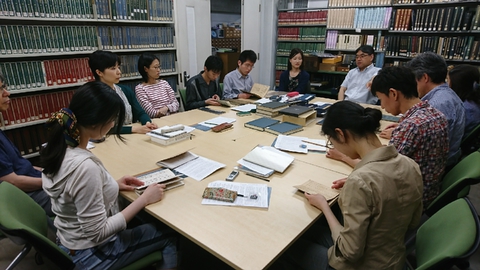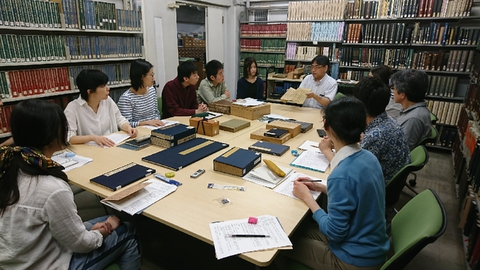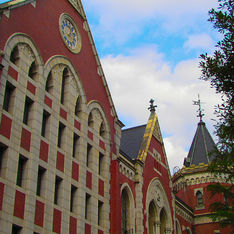Reports
The second Workshop on Bibliographical Studies was held at the Keio Institute of Oriental Classics on May 26th and 27th. Aside from Dr. Sasaki Takahiro, who led the workshop, there were a total of seven attendees, three from Tokyo University, two from Kyoto University, and two from Hokkaido University. As was the case with the first session, this workshop consisted of lectures by Dr. Sasaki along with hands on examination of books relating to the research interest of our participants. This second session used the same texts as those used in the first session.

The first day of the workshop began with an introduction to the Keio Institute of Oriental Classics, and was thereafter occupied mainly with a lecturers about such things as the history of paper and the various types of book binding used in Japan. The afternoon of the second day was dedicated to an explanation, followed by hands on training, of how to discern the various types of rebinding. Participants selected books that bore some relation to their respective fields of specialization and, using special forms created expressly for collecting bibliographical data, recorded their observations regarding such aspects as binding, format, and paper. Dr. Sasaki was generous enough to teach us about yomeiribon 嫁入本, as well as how to distinguish various calligraphic styles. A wide variety of subjects relating to bibliographical studies was covered, making for a very rewarding experience.

As was true of the first session, this two-day workshop offered a valuable opportunity to think more seriously about such issues, and to gain a real hands-on experience of bibliographic studies. Some of the materials made available for examination are quite rare; this was truly a special and intellectually stimulating event for all involved. We offer out sincerest thanks to Dr. Sasaki for making this two-day workshop all possible.
Participants were kind enough to share with us their thoughts on the workshop. What follows is a translation of each of the six participants’ words.
[1.] My research focuses on literature from the late Edo and Meiji periods, for which reason I usually deal with fukurotoji books and printed books bound in the Western style. Often times I do not even handle real books, seeing as how I make repeated use of the on-line digital collection of books held at the National Diet Library. This session provided me with a valuable opportunity to lay my hands on and examine closely books with many different types of binding.
On the first day (May 26th), Dr. Sasaki lectured on the various types of paper and binding. Dr. Sasaki’s knowledge seemed truly limitless; he explained things to us with a confidence that left me in awe-struck, wondering just how much experience it would take to reach his level of expertise. He passed around numerous samples of paper, saying, “This paper is made from mulberry fibers, and this is made from paper bush fiber.” It was interesting to learn with my own fingers the dry, stiff feel of rice paper, and the rough feel of maniaigami 間似合紙. In term of binding, Dr. Sasaki, quite unbelievably, let us examine a precious scroll on which was copied the Tenpyō Sutra 天平経, a work commissioned by Queen Kōmyō 光明皇后 herself. Until that time, I had only been able to view the scroll from behind glass. What a surprise this was!
On the second day (May 27), we first heard a lecture on types of binding (mainly fukurotoji), which was then followed by another lecture on the practice of rebinding. We were told and even shown examples of how, in order to increase the value of a book, bookmakers would go to great lengths in their efforts to rebind the book in question. I was impressed at just how much work was sometimes put into rebinding. There are mystery novels set in old book stores. I thought to myself that the world of rebinding of Japanese books is also full of its own mysteries.
It is not only specialists who find pleasure in imagining the reading practices of bygone people based on the format of their books. General readers, too, can find great pleasure in this. In that way, bibliographical studies are necessary if we wish to enjoy this sort of pleasure.
Kawashita Toshifumi 川下俊文, Tokyo University
[2.] After attending this workshop, I realized that studying the physical format of a book can grant us insights that will help us better understand the content of the text itself. I began to feel that, so long as one is investigating books from a bibliographical perspective, one must have in mind certain objectives: What is it exactly that I wish to learn? How do I intend to use this knowledge? If one does not have such things in mind, one is bound to overlook many things when investigating books. The fact that I was able to participate in this workshop before engaging in any series bibliographical investigation of books was a great help to me.
What left the biggest impression on my mind was the discussion of rebinding. I realized that many scrolls are actually rebound versions of earlier books, and that in order to understand the book aright, it is necessary to investigate its binding history. This is a series issue, and one easily ignored by those who are not aware of the practice of rebinding. This is one example of how a firm knowledge of bibliographical studies can be of significance importance to our research.
Maeda Ryotaro間枝遼太郎, Hokkaido University
[3.] Let me reflect on how I thought about bibliographical studies before this workshop. I used to think that bibliographical studies was something dealing exclusively with material aspects of books, and that it had nothing to do with the textual content of books. Research dealing with texts from a bibliographical perspective did not pique my interest. After attending this workshop, however, my mind has been changed. I now realize that bibliographical studies deals not only with material aspects of books, such as size and other things that can be measured quantitatively, but that it gives us the tools with which to deal more comprehensively with books and texts, looking at everything from types and quality of paper, methods of binding, calligraphic styles, and owner’s stamps.
People like me who held erroneous preconceptions about bibliographical studies, or those who have an interest in the field should certainly attend this workshop.
Um Kyofum 厳教欽, Tokyo University
[4.] Personally, I was interested in the difference in terminology for book binding styles used in Japan and China. After listening to Dr. Sasaki’s explanations about the differences in bibliographical research between Japan and China, I finally understood, for example, why Chinese use the terms hudieben 胡蝶本and xianzhuangben 線装本, while Japanese use the terms decchōsō 粘葉装 and fukurotoji 袋綴. It was interesting to learn that the prestige of a book could be altered depending on its binding, and I wondered whether or not the same held true in China. I became interested not only in Japanese bibliographical studies, but in Chinese bibliographical studies, as well.
More than this, however, I was delighted to have an opportunity to touch with my own hands books that had been made hundreds of years ago. It was a dream come true for me to be able to handle a manuscript of Youxianku 遊仙窟 preserved only in Japan, something directly related to my own research.
Wu Xi 武茜, Doctoral student at Tokyo University
[5.] Dr. Sasaki’s explanations of orthographic styles left a deep impression on me. Much was said about the Asukai style of calligraphy. It is in virtue of that fact that there are distinct styles of calligraphy that we are able, by looking closely at a manuscript, to discern which style the copyist if that given manuscript studied. Before the workshop, I had relied solely on postscripts (okugaki) to obtain data about a given book. Now, however, I see, even in the absence of any postscript, it is yet possible to gain some hints about the copyist by looking at the calligraphy. I felt a sense of shame when I thought of all those times when, not finding a postscript, I hurriedly concluded “copyist unknown,” as though there was nothing more we could learn.
I thought about how important it is for us to examine premodern books with our own eyes and hands in order to glean as much information as possible. Dr. Sasaki’s knowledge was by no means limited to distinguishing calligraphic styles. At a glance, he was able to know that the cover of a certain book had been taken from an older book. Only after much scrutiny was I at last able to discover that what he had said was indeed true. Despite my own ignorance of bibliographical studies, it as my good fortune, on the second day, to be taught the basics of how to properly investigate books and record bibliographical data. Hopefully I will be able to put what I have learnt at this workshop to good use in the future.
Sasaki Tomoko 佐々木朝子, Hokkaido University
[6.] On the second day of this workshop, we were given the opportunity to lay our hands on a number of books stored at the Keio Institute of Oriental Classics. I examined a rare manuscript, the only one of its kind, entitled Fuyin pangxun jujie lunyu 附音傍訓句解論語 (in two volumes). This manuscript was held by Kiyowara no Nobukata 清原宣賢, and was bound after the hōhaisō 包背装 fashion. The book itself contains many hints, including owners’ stamps, about the transmission history of this book; the warmth of all those hands that had handled this book so many generations ago can still be sensed. I felt as though the distance between each of those past readers was not so far after all.
Dr. Sasaki shared with us the special cards used when investigating Japanese books, and showed us how to fill everything out so that no information is missed. The detailed investigation of a single book requires the recording of some 32 different types of information. Although measuring the size of a book may appear rather mundane, it can help in distinguishing one edition of a printed book from another. Even the position of an pasted title label (daisen 題簽) can give information pertaining to the genre of a book.
Wang Yiran 王怡然, Graduate student at Kyoto University
[7.] Although I had handled many printed premodern books in the past, I had never been aware of their special characteristics or even their differences. I had no idea there were so many different sorts of paper. Nor was I aware of the fact that different sorts of paper made for different levels of prestige or value. Moreover, only after handling a number of books during the workshop was I able to gain some understanding of the different types of binding. I now have a clearer understanding of the origin and development of these aspects. It will be possible for me, equipped as I now am with this knowledge, to develop a more theoretical understanding of the world of books.
Personally, I was most interested in those rare books of which the Keio Institute of Oriental Classics is rightly proud. I was able to touch with my own hands a number of Song period books, some handwritten records and letters written by Qing scholars. I was able to examine the quality of paper of these works as well as measure all sorts of things, including outer title labels (gedai 外題), postscripts, publication notes, and page lines. I found this workshop extremely interesting and stimulating.
Yang Wen 楊雯, Kyoto University



